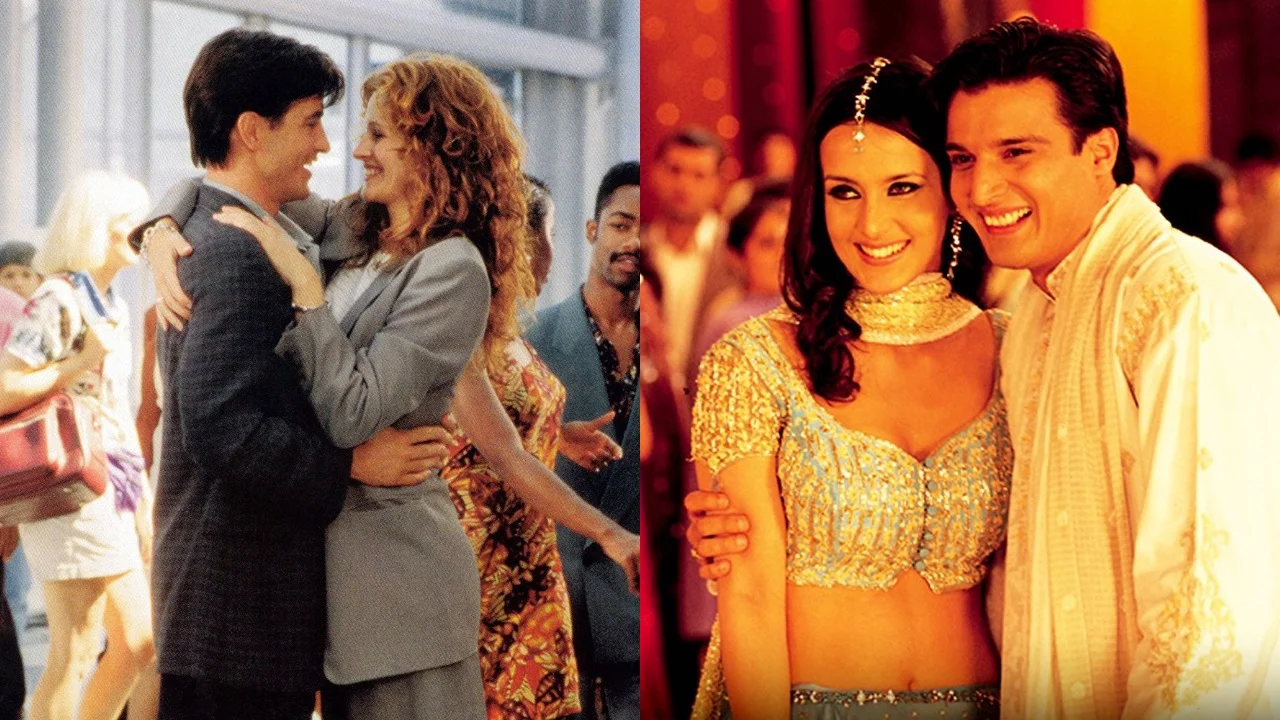Hollywood vs. Bollywood: The Wedding Rom-Com
In 1997, Julia Roberts gave an iconic lead performance in My Best Friend’s Wedding. The film subverted many rom-com clichés and provided the actress with a chance to deconstruct her America’s Sweetheart persona. Five years later, the Indian studio Yash Raj Films made its own version of the film, Mere Yaar Ki Shaadi Hai (It’s My Friend’s Wedding), this time with rising star Uday Chopra in the lead role. While the title is an almost exact translation, the Indian film isn’t a copy of the American one. How the two films are similar and how they are different, however, is a fascinating study at how each industry looks at genre and gender.
The basic premise of both films is that both main characters find out their best friend is engaged to someone else, realize that they are in love with said best friend, then hatch a plan to stop the upcoming wedding. Both Wedding and Shaadi differ in two key ways, though. The Hollywood film stars a woman (Julia Roberts as Julianne) and the Bollywood film a man (Uday Chopra as Sanjay). Wedding runs 105 minutes, while Shaadi is almost an hour longer. The difference in gender is essential in how each character is framed within his or her own narrative, and lays the foundation of the ending. The Bollywood version of the film changes the ending, a decision telegraphed from the very start.
In Wedding, Julianne and Michael (Dermot Mulroney) became friends after dating in college for a brief time. In Shaadi, Sanjay and Anjali (Tulip Joshi) are were inseparable as children and grew up together. The stakes are higher for Sanjay than they are for Julianne. His love is more romantic while Julianne’s is more possessive. Another difference: Sanjay is presented as a romantic hero out to win the heart of the girl he loves. Julianne, by contrast, is crazed, obsessive, and brash. The opposing depictions of this romantic pursuit are very striking. Perhaps we are more comfortable seeing a man chase after a woman; a woman going after a man—an attached man at that—upsets the balance too much. That’s why Julianne is an anti-hero.
The characterization of Michael and Anjali also differ. Anjali is a dream girl, feisty but simple. Michael is your typical late 90s guy, selfish, clueless but somewhat charming. Shaadi makes it abundantly clear why Sanjay is in love with Anjali—who wouldn’t be? Wedding, on the other hand, is less convincing about what attracts an accomplished, striking Julia Roberts to this idiot. Anjali is more of a conventional romantic object, while Michael subverts that character type. In both films, the rival Kimmy (Cameron Diaz) and Rohit (Jimmy Shergill) are played the same. They are both so charming and hard to hate, with everyone practically worshiping the ground they walk on. The one difference is that Rohit and Sanjay become gentleman rivals over Anjali. Kimmy and Julianne don’t exactly fight over Michael, until she sees Julianne kiss Michael.
Julianne’s sabotage is also far more psychopathic than Sanjay’s. She crosses a line that Sanjay doesn’t even come close to (the worst he does is get Rohit drunk at his bachelor party). Julianne’s gay best friend George (Rupert Everett) becomes Sanjay’s roommate Riya (Bipasha Basu), and they both come into the film to make Michael/Anjali jealous. Both characters are charismatic and magnetic. George is very funny and tells a hell of a story. Riya commands attention through her beauty, with her glamorous Western outfits contrasting with Anjali’s traditional attire. Shaadi adds more attention to the extended family members, developing a more lived-in universe (something Wedding doesn’t quite accomplish).
Both My Best Friend’s Wedding and Mere Yaar Ki Shaadi Hai are well-made films doing different things. The Hollywood film is subversive, with an enjoyably unlikable character and bittersweet ending. The Bollywood film takes the barebones premise and adapts into a glossy albeit predictable family musical. Bollywood had been infamous for taking the premise of an American film and making it more suitable for Indian audiences. In this case, the two films provide a glimpse into how gender plays into rom-com conventions.















